December 23, 2023 Lunch at the Beach (Day 87)
After a morning of organizing and cleaning the car interior for our move to the south island in 2 days we drove the 1.4km down to have lunch at Makara Beach WhareKai, ‘dining hall’ in Maori. It is a quaint cafe that is open only on weekends and is run by the couple that deliver the mail here! It was threatening rain but there were lots of beachgoers. Some were lounging on the cobble beach, some walking the path around the beach, even several snorkelers in wet suits emerging, one with a speargun! It was a calm day at the beach wind wise!
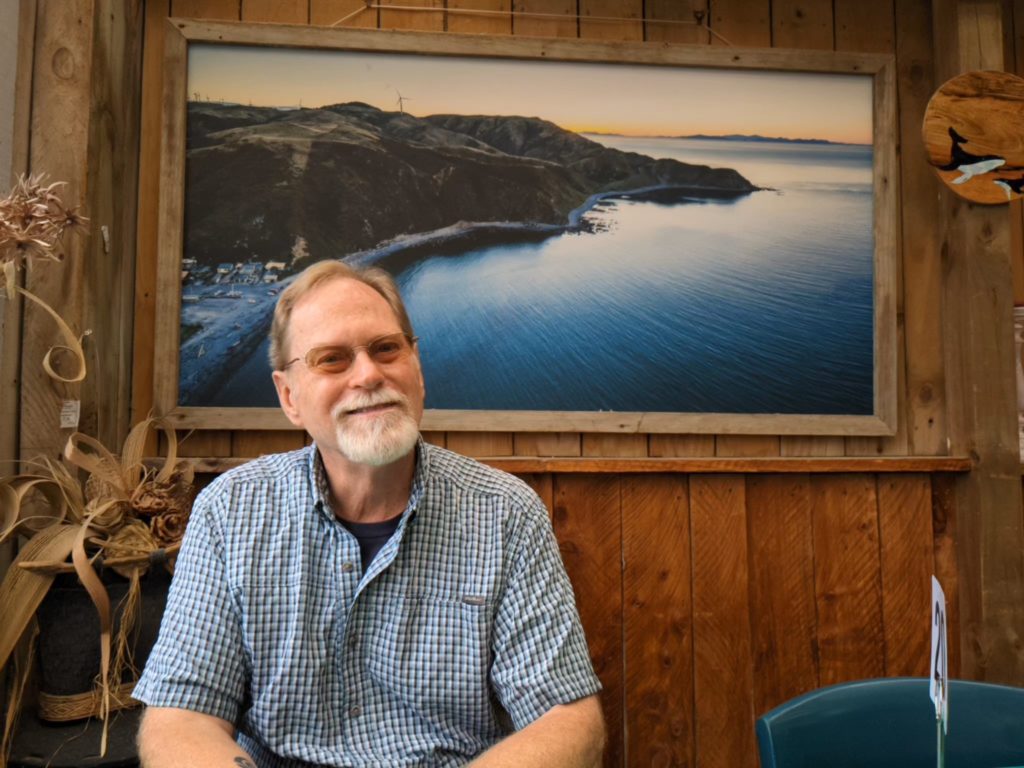
Robert with an aerial view of Makara Beach behind him.
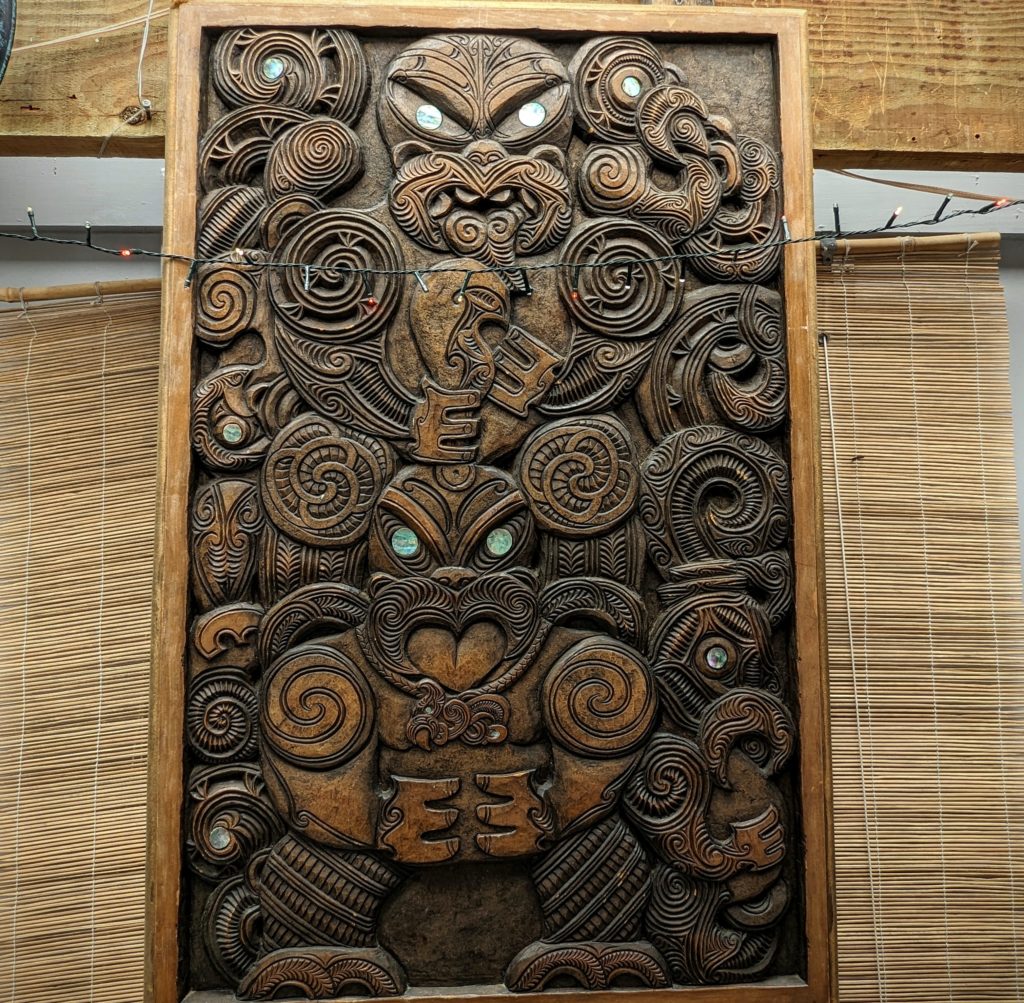
An intricately carved panel in the dining hall. You can see how much the koru is used in the carving. “Koru, ‘loop or spiral’, is based on the appearance of a new unfurling fern frond. An integral symbol in Maori art, carving and tattooing, where it symbolises new life, growth, strength and peace.” per wikipedia
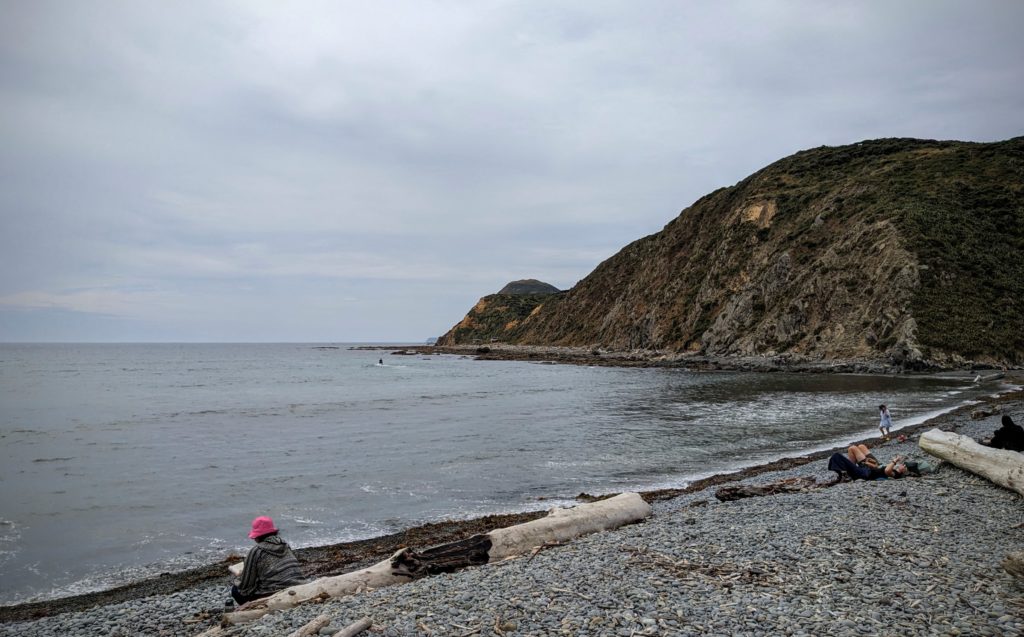
The beach is calm today!
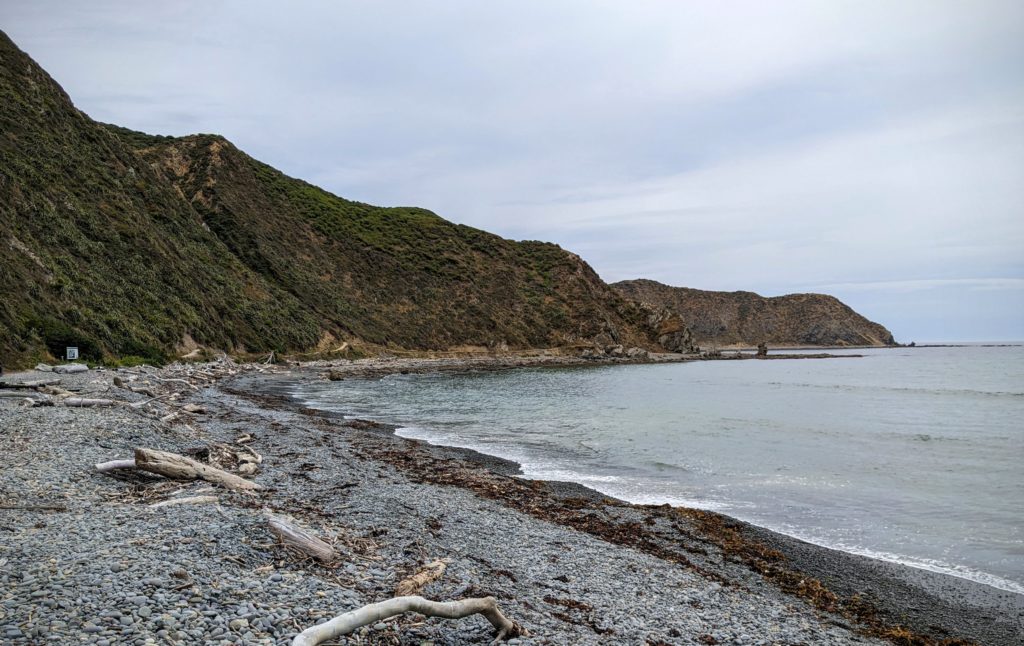
December 22, 2023 Otari-Wilton’s Bush (Day 86)
Overcast today, but warm and calm. We drove down towards Wellington and turned slightly north to the City Park called “Otari-Wilton’s Bush”, the only botanic garden in New Zealand dedicated solely to native plants! And like all other city parks, entrance is free! ‘Otari’ is a Maori word meaning ‘place of snares’. When Maori arrived in the area it was covered with dense podocarp broadleaf forest in which they hunted birds. I’ve heard the term ‘podocarp’ used a lot in describing forests here in NZ. HERE is the best description of the NZ podocarp trees, basically a southern hemisphere conifer that bears cones and fruit. Not to be confused with the introduced pines that are grown here for lumber or wind breaks. Needless to say, most of the NZ native forest was cut for lumber or burned to create pasture for the sheep and cattle that were introduced in the mid 1800’s. About 17 acres at this spot was protected by Job Wilton, one of the early European landowners. It was eventually purchased by the city of Wellington and has been expanded to create this unique reserve in the city limits!

The carved gate at one entrance to the park.
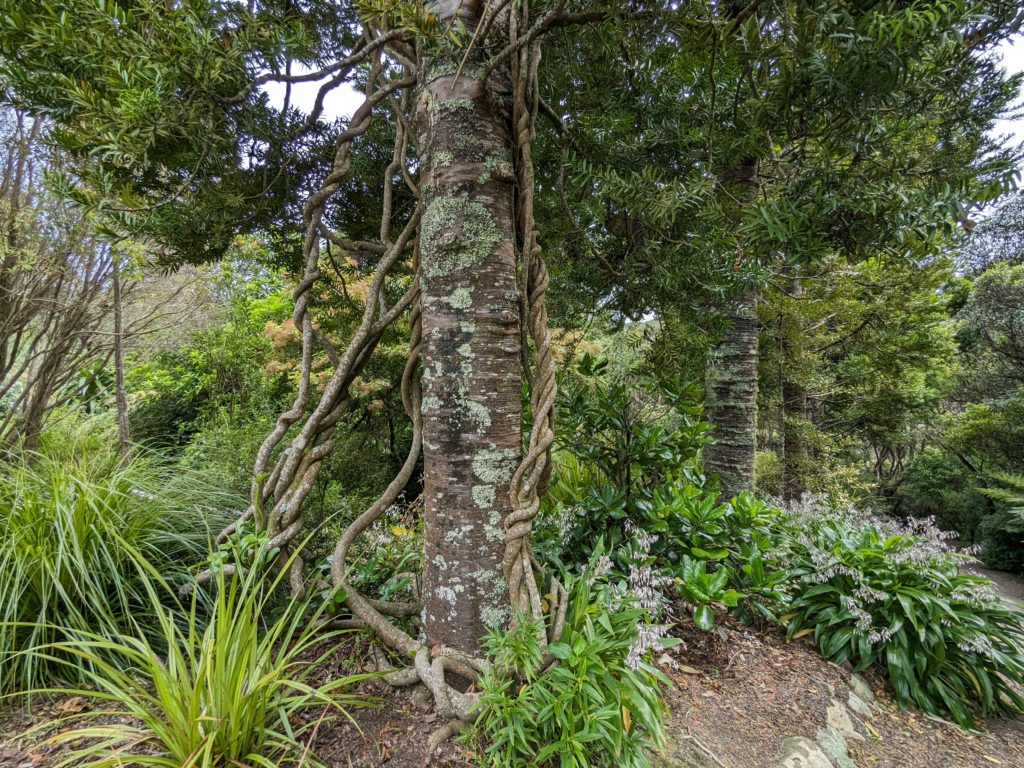
A native tree supporting native vines.
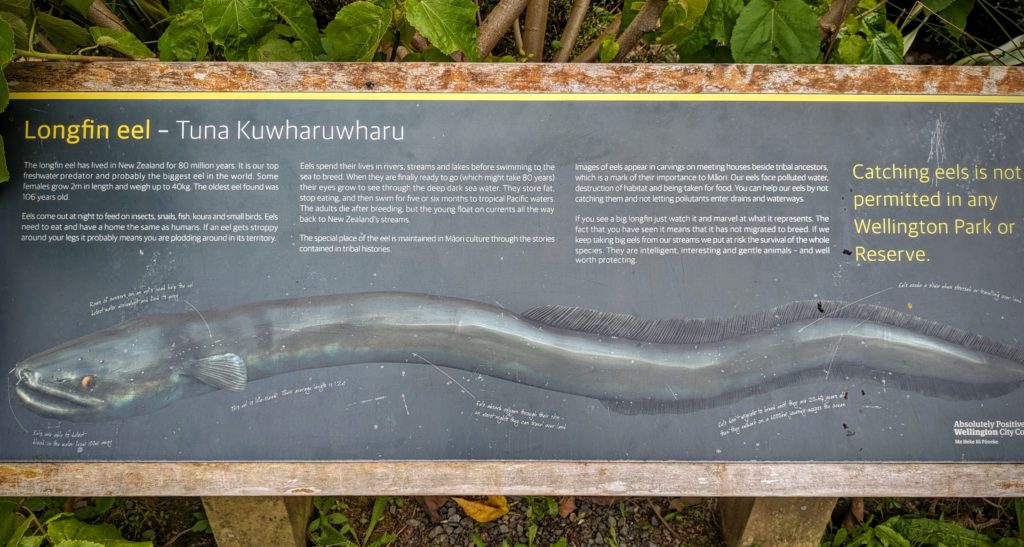
A creek runs through the park, harboring eels. I learned some new things about eels. They live in fresh water, then at maturity (20-60 years!) they swim to tropical ocean waters to breed (no one knows where exactly!) The young ‘glass eels’ are carried by currents back to NZ where they swim upstream to live until maturity!
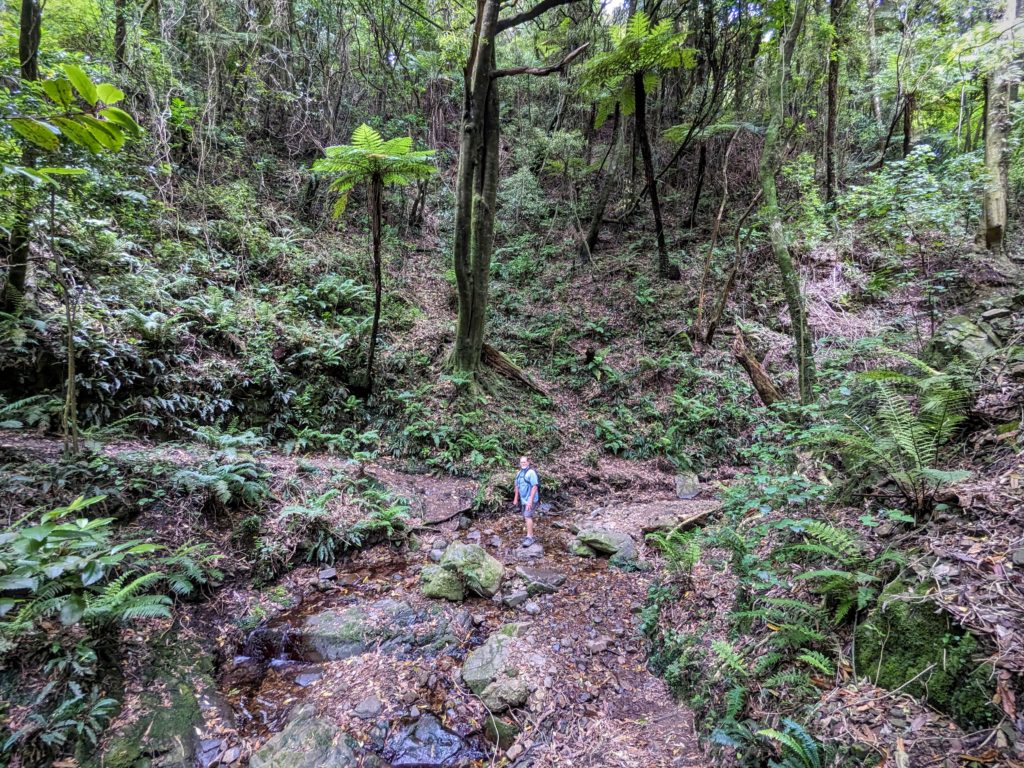
Crossing a tributary creek, the scale shows how big the tree ferns can get!
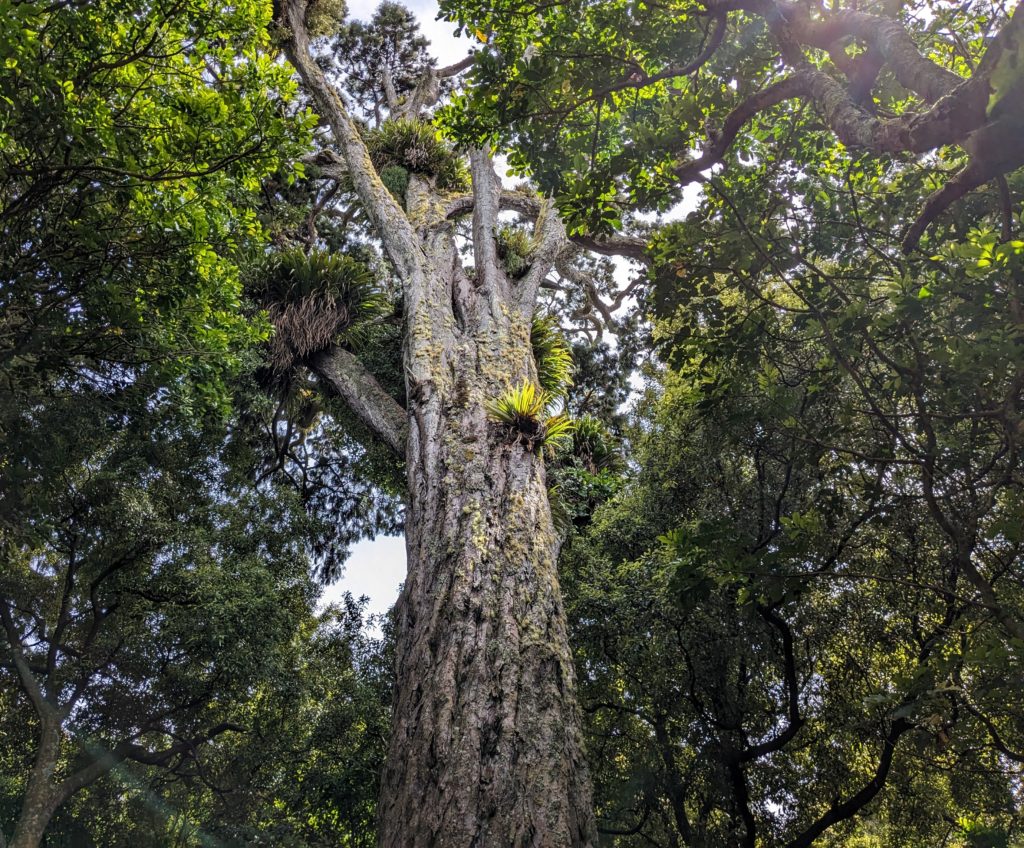
Moko, the 800 year old rimu tree (a podocarp) we hiked to.
December 21, 2023 Remutaka Rail Trail (Day 85)
This morning was grey and misty, but we had plans to escape over the Remutaka* range to the east where it was predicted to be sunny and warm! We drove today, our destination the terminus of the Remutaka Rail Trail, a hiking and cycling trail that follows the 1878 Remutaka rail line that connected the eastern Wairarapa region to the markets of Wellington. The Wairarapa region is named from Lake Wairarapa (in Maori mythology it is the eye of the fish that is the north island that the demi-god Maui fished up from the sea). It is a very rural area raising beef and dairy cattle, and sheep. In the 1980’s a viticulture industry began and the area is now known for its wineries and olive groves. The spine of mountains dividing the eastern area from the wetter western side creates a rain shadow and the Wairarapa tends to be warmer and sunnier than Wellington, but colder in the winter!
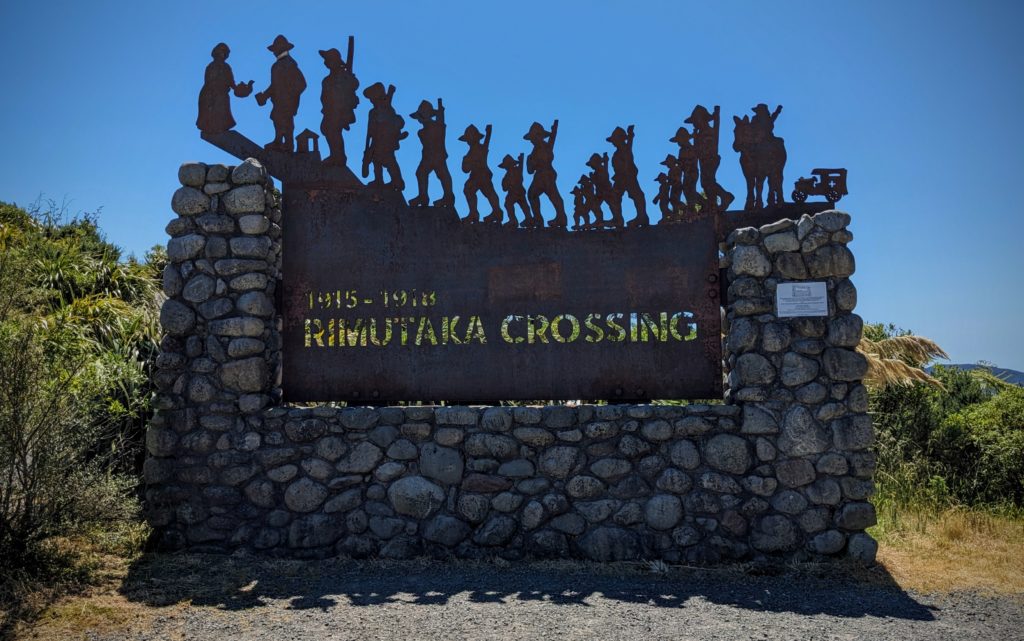
As we left the mist behind and crossed the summit of the road we stopped at the ‘Rimutaka Crossing’ view point.
This commemorative structure memorializes “the thousands of infantry soldiers who marched over the Rimutaka Hill (from 1915 to 1918) prior to their departure to the Western Front as part of the New Zealand Division in WW1.” It was a 27 mile, 3 day march for the soldiers, mostly from the Wairarapa region and further northeast, on their way to the infamous warfare trenches of Europe.
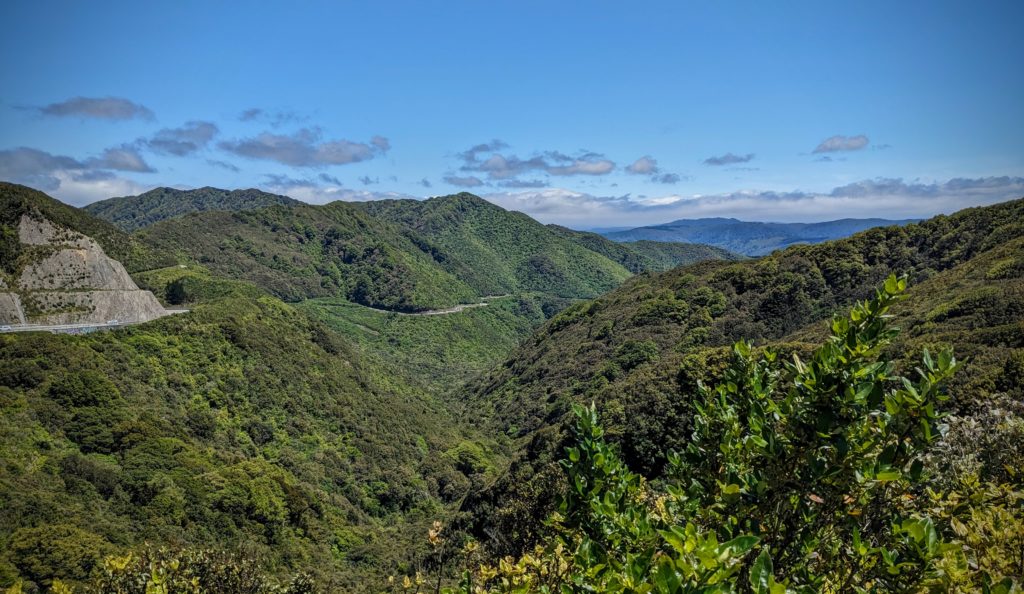
Looking back past the hills towards the mist engulfing the Wellington area.
We descended from the summit into the tiny town of Featherston and turned right onto the road to the Rail Trail. We arrived to brisk winds flowing up from Palliser Bay on Cook Strait, winds coming up the valley of Lake Wairarapa all the way from the east side of the south island! We hoisted our day packs, tightened our hats on our heads and headed up the trail. We started out through a regenerating forest, with shade and kawakawa bushes, along a stream. Then we came out into the open to the actual rail bed at Cross Creek camp. It was a small community of railroad workers at the end of the steep downhill run of the railway, before it followed the valley up to Masterton, the largest town of the Wairarapa region. Very little of the town is visible, but plaques with history and pictures tell the story. The Railway was operational from 1878 to 1955, 77 years!

Soon we headed up ‘The Long Straight’ as this 299 yard section was known, the longest section of straight track on the whole line, only 274 meters!
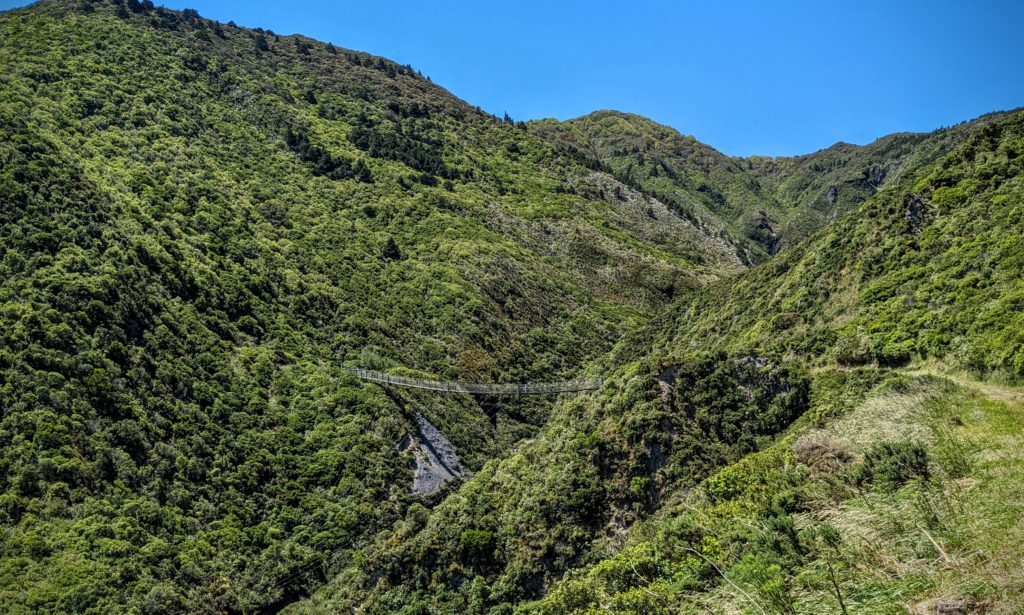
Three and a half miles into our hike we spotted our goal – The Siberia Suspension Bridge!

As we approached the bridge the wind was whipping even stronger and we read this information!

The bridge is about a football field in length and was visibly swinging in strong gusts of wind! But we braved it and headed across!
We made it across the bridge! Then went through the Siberia tunnel at the other end and turned around to retrace our steps back over the bridge and back down to Cross Creek where we ate our picnic lunch. We had one more destination on our list, another suspension bridge in Kaitoke Regional Park, on our drive back towards Wellington!
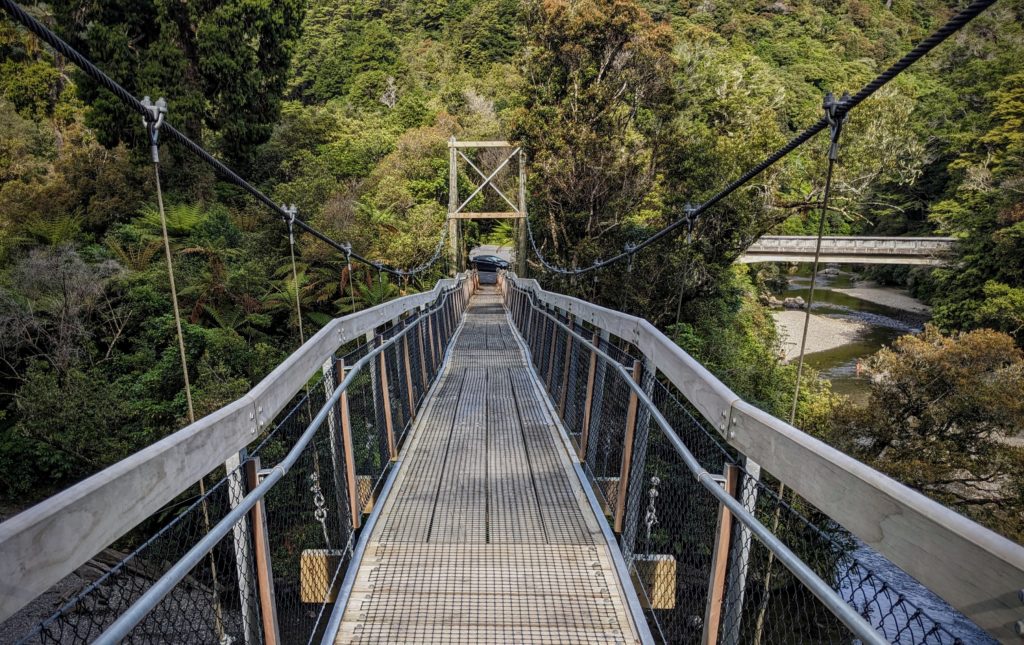
This was an easy one to get to! See our car at the end of the bridge?
We were glad for the quick and easy access to this bridge, the 7 mile hike in the sun and wind really wore us out! We got home in an hour and a half, and grilled some lamb burgers for dinner!
*Remutaka; all things Remutaka (range, forest park, rail trail, etc.) used to be spelled Rimutaka. I don’t know when the spelling change occurred but the NZ Travellers Road Atlas we bought 3 years ago has the Ri spelling!
December 20, 2023 The Next Day (Day 84)
Farm to Zoo – Part Two!
This morning we got a message from our host that the sheep had been rounded up and the shearing was beginning! We quickly finished our breakfast and headed up the hill, on foot this time, to see the process! We got to the top not too winded from the climb, the driveway to their house is the steepest part, the dirt road up to the paddocks is less steep and we can stop to catch the views, and our breath! The sheep were indeed in the pens, many had already been shorn and the shearer and his helper were busy!
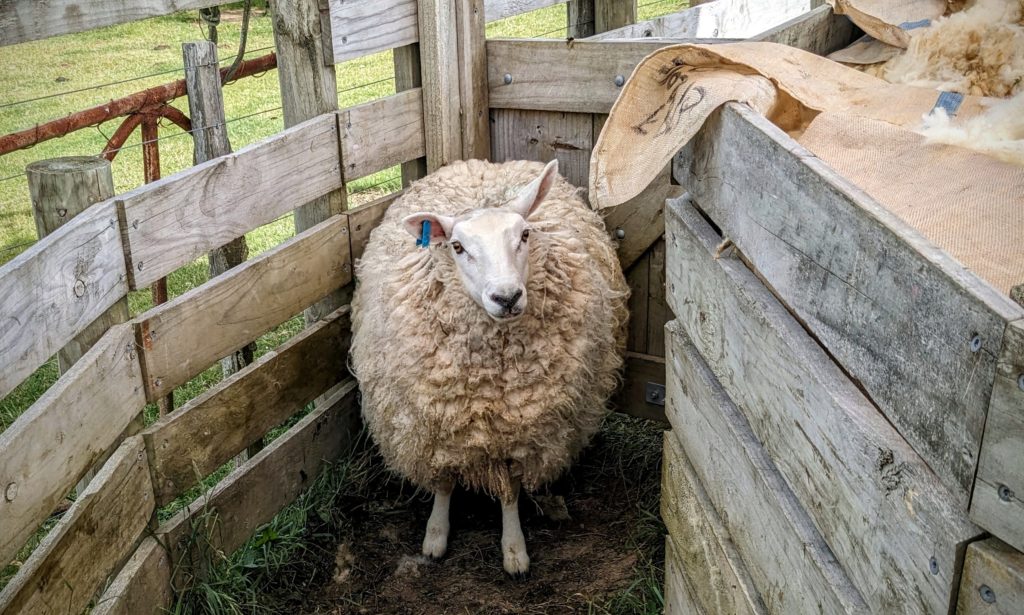
A roly-poly ewe trying to hide at the back of the chute!

The shearer’s sheep dog, laying quietly as if saying ‘my job is done!’. Maybe an Australian shepherd – border collie mix?

The shearer in action, almost done with this ewe, her wool piling up on the ground in front of her! He will shear about 100 sheep today, half from this ‘small holding’ and half from the neighbor’s.
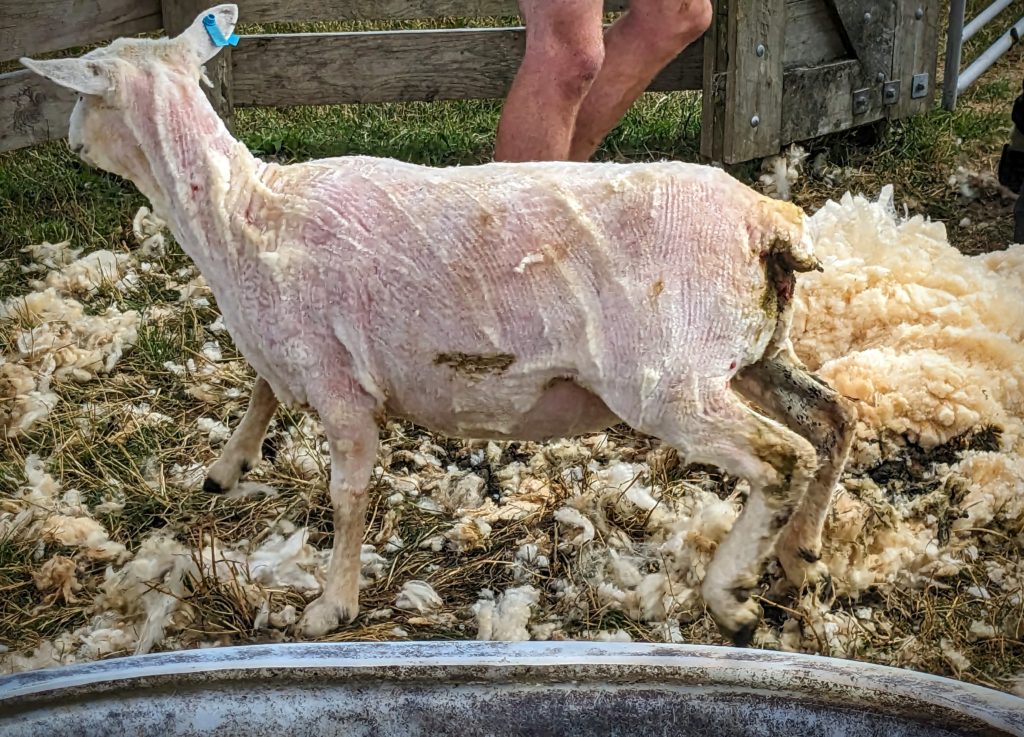
The shorn sheep looking for the exit!
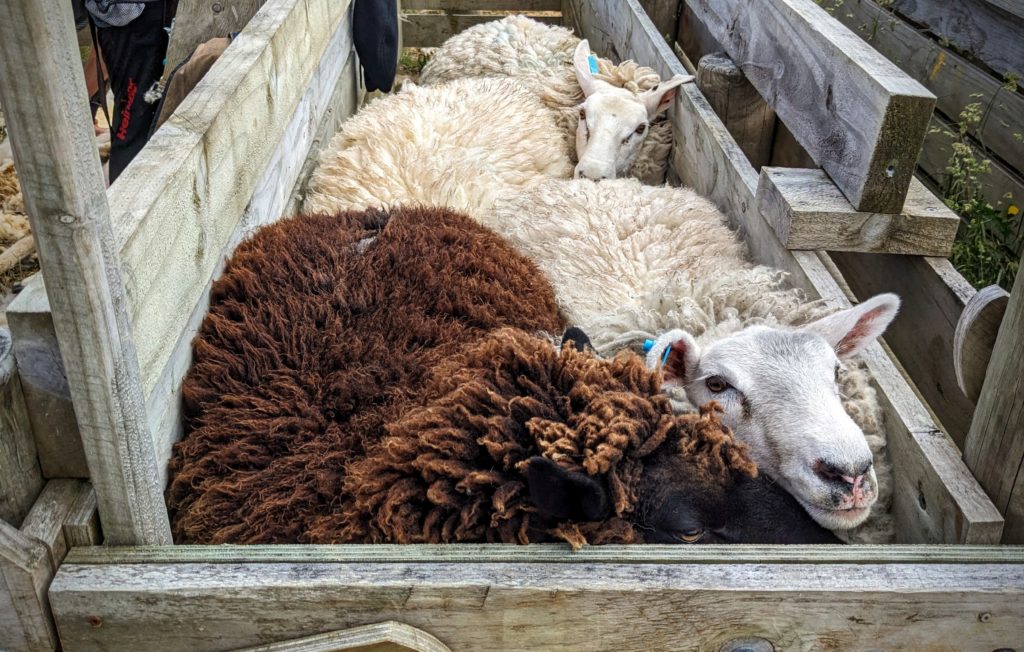
Who’s next? I heard the shearer talking with Jack, the brown sheep will be last, to keep from mixing the white wool with the brown.
I heard the shearer and Jack talking of ‘dog tucker’ which we learned from the “Footrot Flats” play is the euphemism for old sheep that have outlived their usefulness as farm animals, or rams that are not suitable as breeders, and can be used as dog food now! These ewes in the chute are the last to be shorn of Jack’s flock. The next process was to catch up the ram and his companion, a wethers (castrated male) to shear. We decided to head back down the hill to stay out of the way of the “circus” Jack said that roundup would be!
Since our Zealandia Dusk Tour ticket entitled us to a visit the next day, we wanted to take advantage of that. We drove down to Karori and re-entered the world of Zealandia. Once inside the fenced park we headed up to the outer paths, away from the general hubub and enjoyed a wonderful 4 mile hike through the forest.
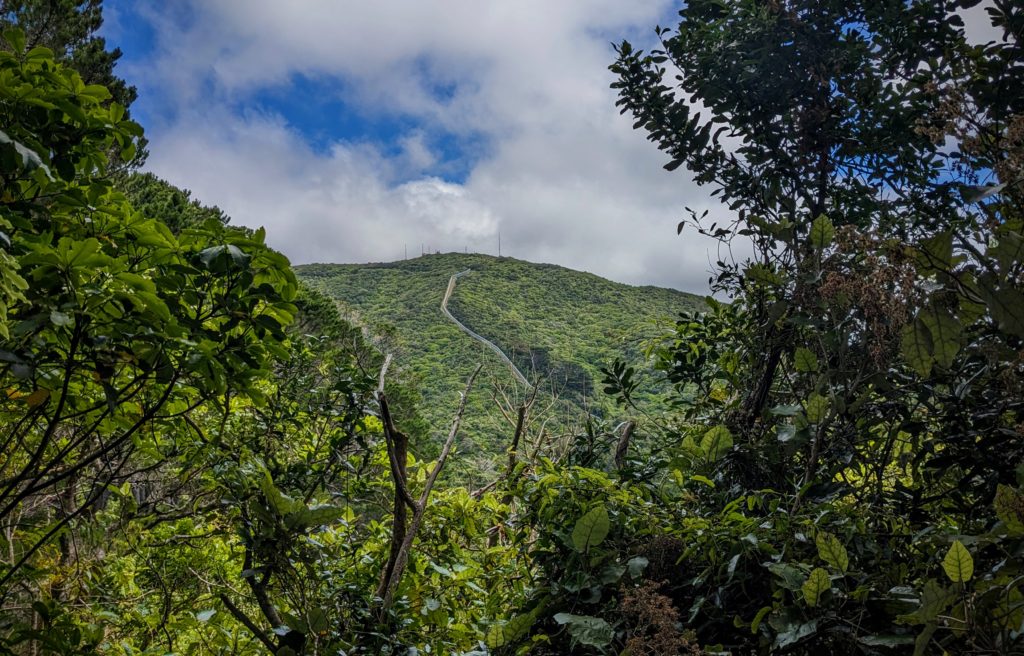
Across the valley we could see the exclusion fence on the far hillside. It encloses the entire 500+acres of the sanctuary!
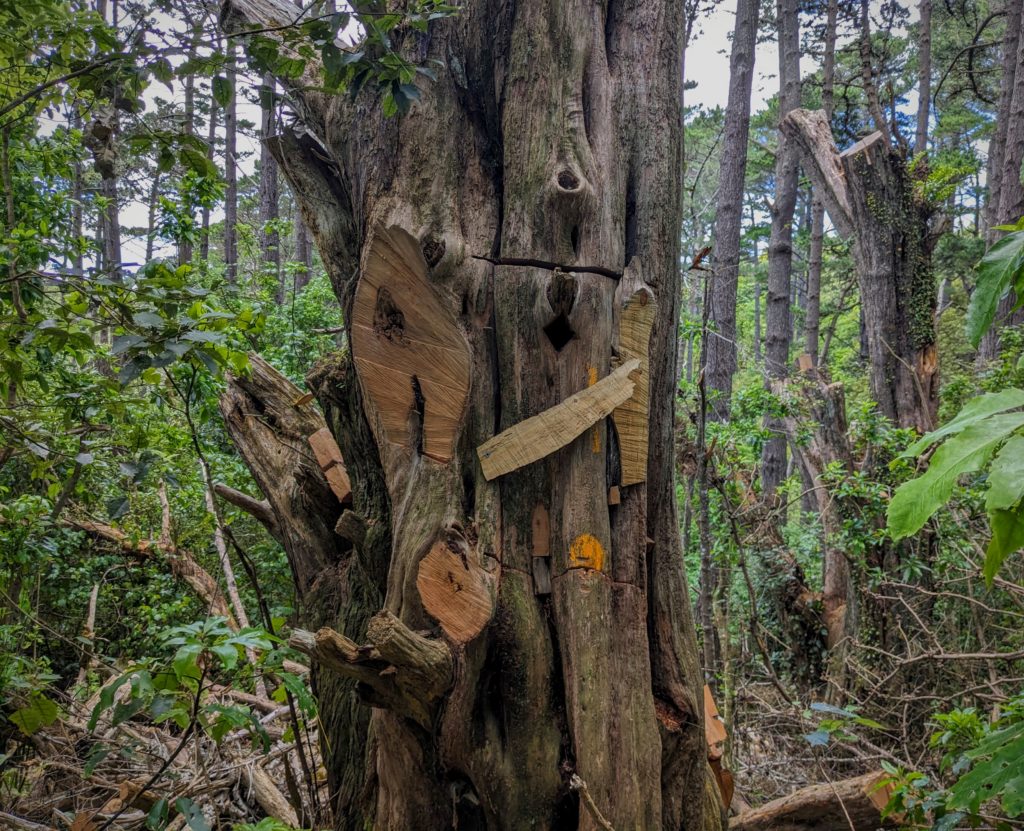
We passed by this trimmed tree and puzzled at the jigsaw cutout. We decided it might be a nest box with a removable door?
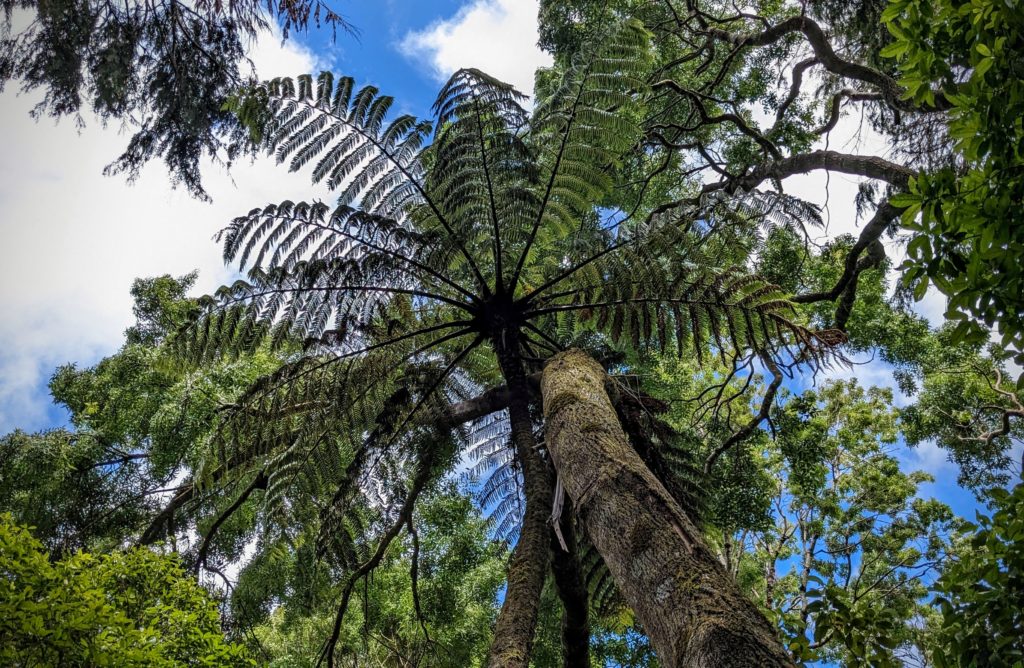
Further along we learned about the black tree-fern, the largest of the tree ferns, this one towering about 60 feet above us!

As we walked on paths far from the crowds we encountered several different birds. This kaka parrot actually came to check us out! It looked us up and down then took off just over our heads, showing off its flight abilities through the trees!
We also heard a sweet birdsong, stopped and listened and then saw a unique bird, a tieke, or saddleback bird. A robin sized black bird with an orange ‘saddleback’ and bright red wattles at the corners of their beak! Not only one, but two! A pair? Or a parent and young? We don’t know. They were close to extinction at the end of the 20th century but are slowly recovering due to the predator trapping program and predator free sanctuaries like Zealandia!
We headed back down to the upper reservoir, then to the pathway past the tuatara research area.

A tuatara basking in the sun.
We finished our daytime self-guided tour in the visitor center where we got head-exploding information about Zealandia and came away with this quote;
December 19, 2023 Farm to Zoo (Day 83)
Farm;
Early this afternoon Jack kindly gave us a ride up to the paddocks in the side-by-side so we could meander in the meadows and take pictures. It was a decidedly better day for pictures today too! Clouds passed above us, giving us some sunny moments and though the breeze blew, as it does just about every day here we think, it wasn’t too cold or strong.
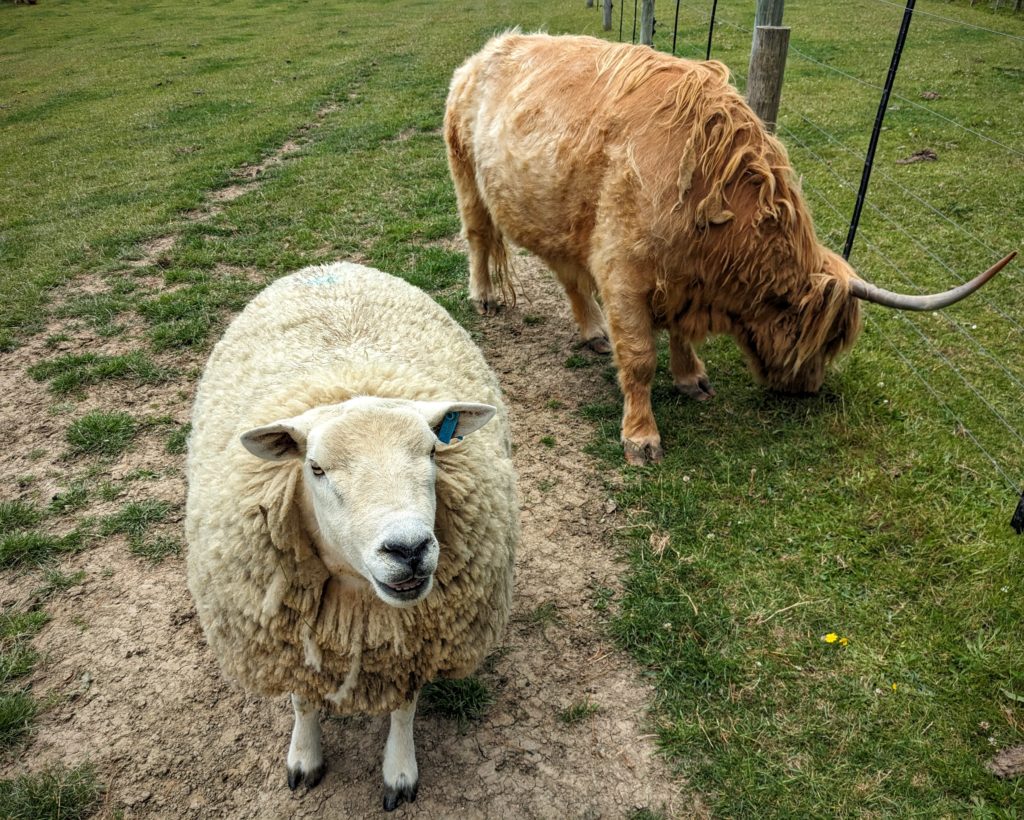
The ram greeted us at a gate, demanding his tribute of pelleted feed for entrance into ‘his’ paddock. We didn’t have any feed with us, so we passed by.
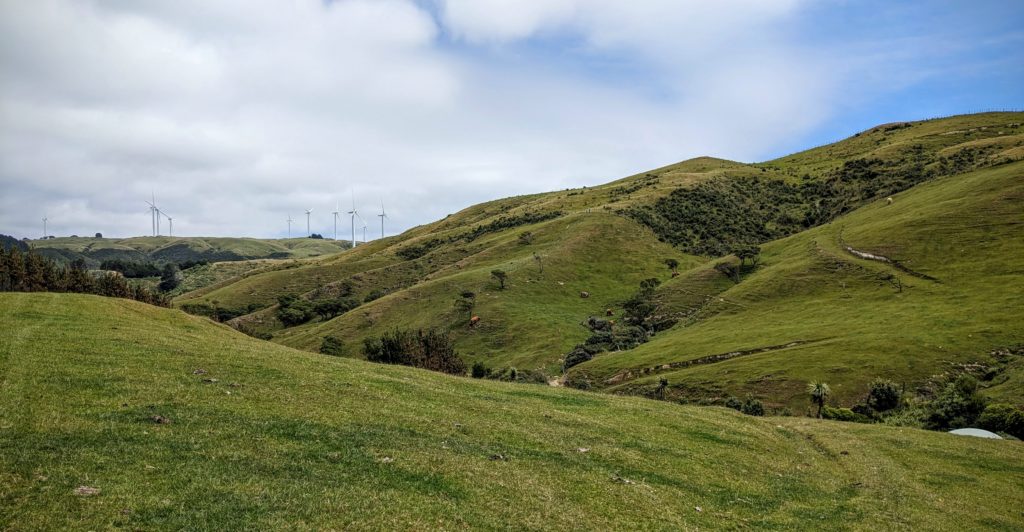
The hills rolled out in every direction. To the south and west you can see the windmills that capture that breeze as it flows from Cook Strait up the coastal hills.
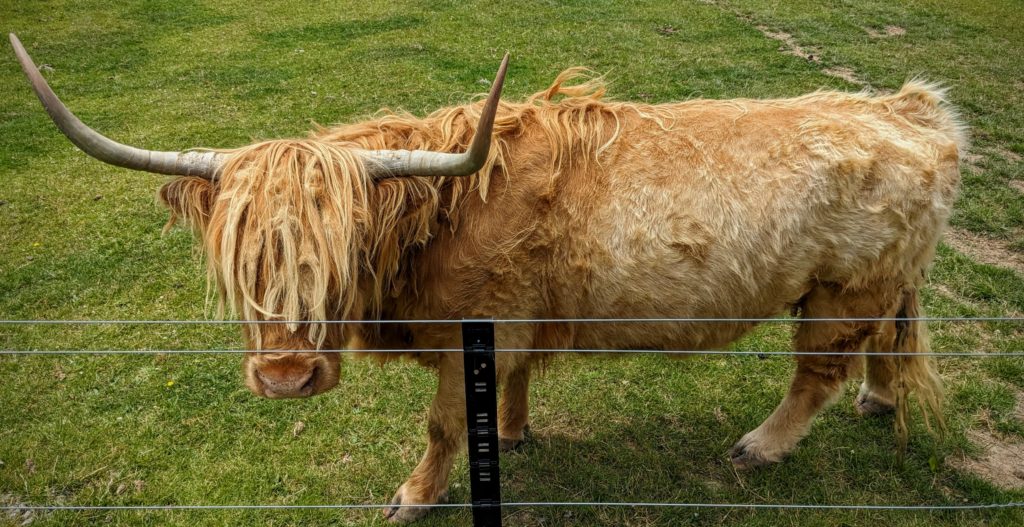
The friendliest of the Highland cows that they “keep as pets now since the bull died” Jack told us. Some of the ladies are in their mid teens, they can live to about 20, considered a longer lifespan than most other breeds of cattle.
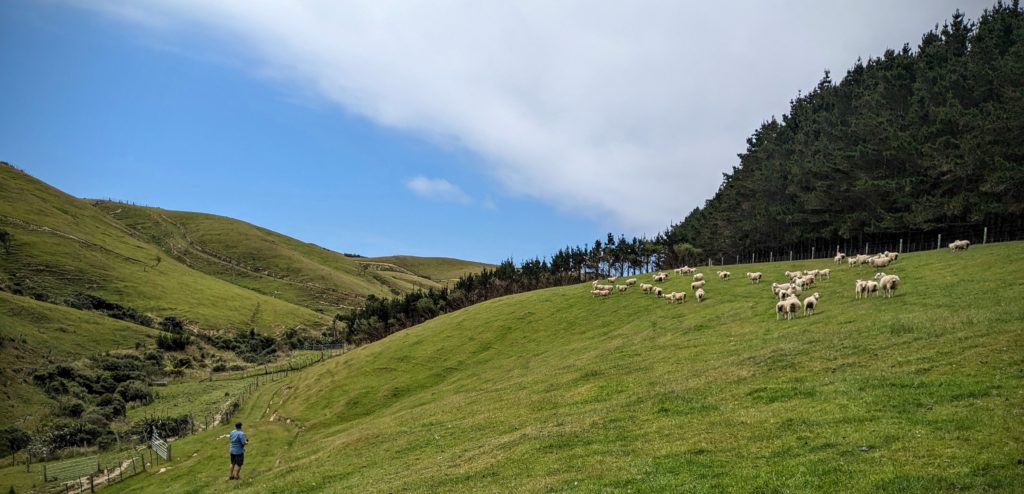
In another paddock is the herd of ewes and this years lambs. This was as close as we could get to them!
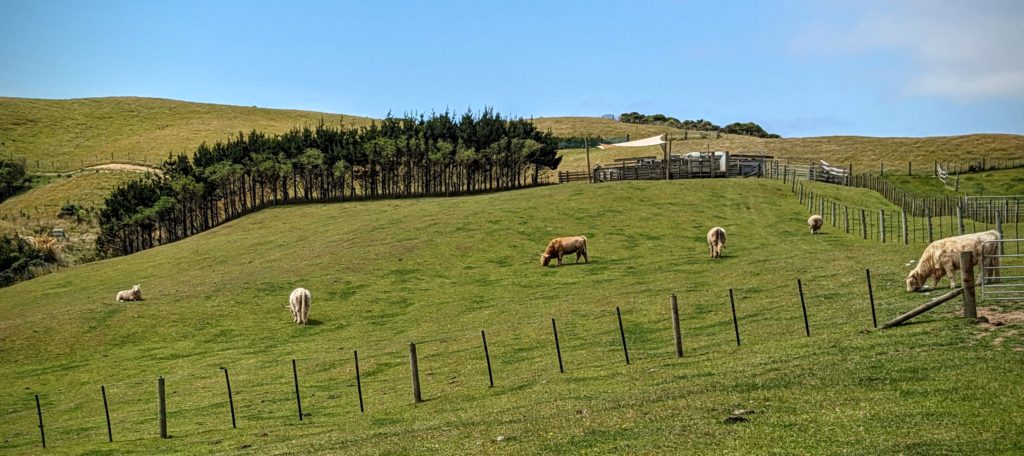
This is the paddock guarded by the ram. In the background is the shearing pen with a shade sail installed for the imminent shearing session.
Zoo;
Not really a zoo, but a wildlife sanctuary, originally called the Karori Wildlife Sanctuary, now called “Zealandia”. Katy and Steve that we met on Friday gave rave reviews of the night tour they took the night before. We tried to book a night tour, touted to give you a possible glimpse of kiwi, but they were all booked up, so we settled for a dusk tour. So after our farm photo tour we got cleaned up, ate a quick dinner and headed the short winding drive down to Karori and Zealandia for our 7:15pm Dusk Tour! We arrived and along with 10 other guests on our tour (a limit of 12 per tour, so book early!) we stepped into the 500+ acre fenced sanctuary to see the sun setting behind the hills overlooking a reservoir.
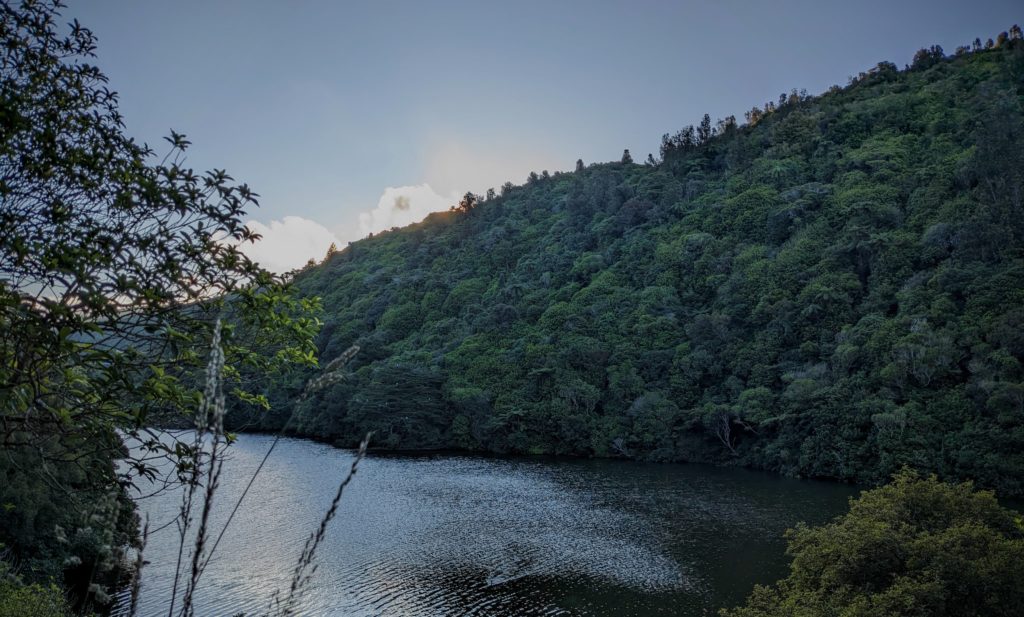
A centerpiece of the sanctuary, the reservoir was originally the water source for Wellington. When it was discovered that it sits over an active fault line the dams were decommissioned and the upper reservoir was partly drained. A good history of the transfer into a wildlife sanctuary can be found HERE.
Our tour guide explained the fencing system that keeps the introduced predator species like cats, dogs, weasels, stoats, rats, mice, possums, etc. OUT of the sanctuary. The native bird species that can fly are able to come and go from the sanctuary at their pleasure. The flightless birds, like kiwi and takahe and the reptile tuatara were introduced INTO the fenced sanctuary and have been thriving and reproducing. An interesting note is that before humans arrived in New Zealand about 1200 years ago the only land mammals were 2 species of small bats (marine mammals like seals and whales have been around the coast)! All other mammals have been brought intentionally or not into NZ!
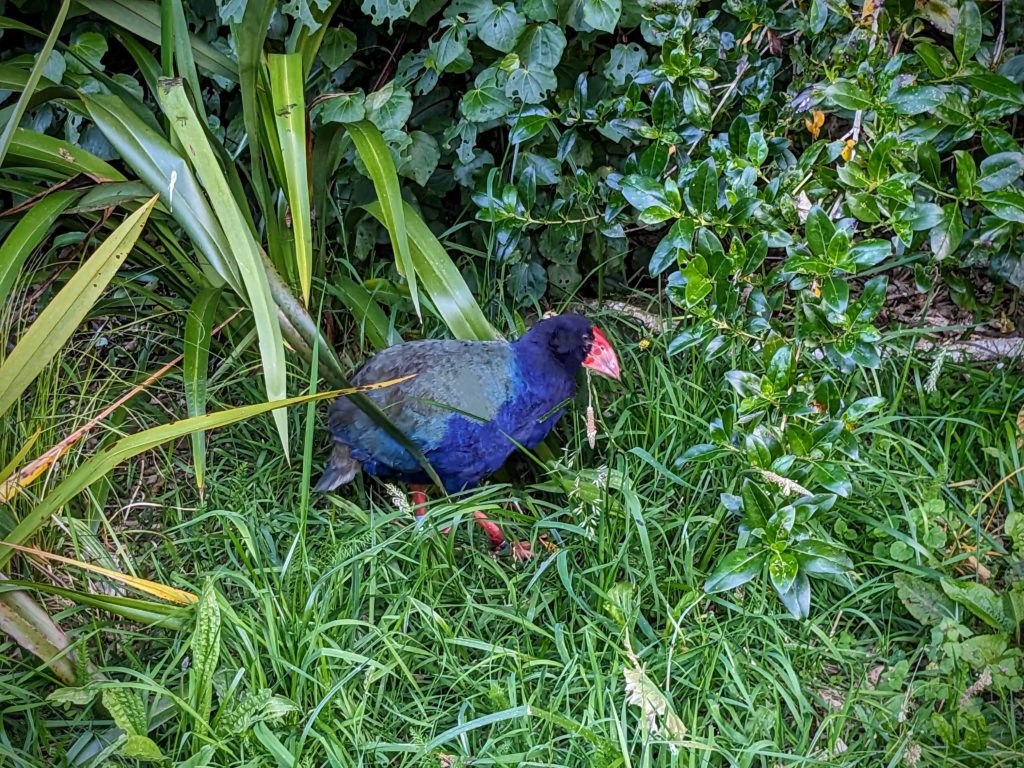
A flightless takahe that is familiar with people strutted around us as it’s history and status as a threatened species was explained. There are only about 500 left in the world.
There is a fenced area inside the fenced sanctuary that is a tuatara research area. I remember learning about ‘the tuatara, the living fossil with a third eye’ back in high school! I don’t remember that it is a species confined to New Zealand!
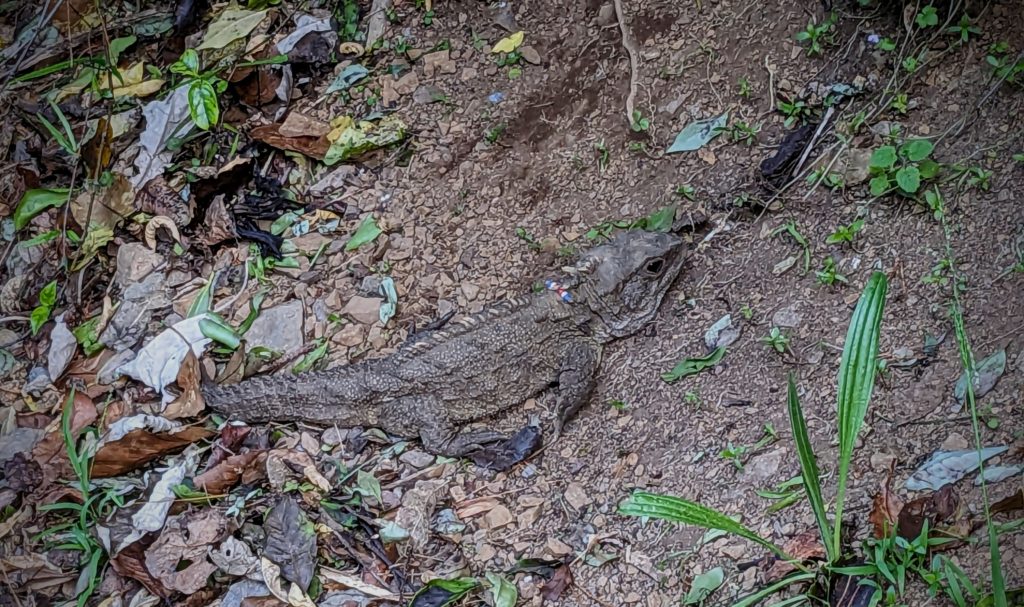
We saw several tuatara, looking like lizards, but they are not lizards, they are however reptiles and the only surviving member of their order Rhynchocephalia. This one sports an identifying beaded ‘necklace’ pierced onto the back of its neck.
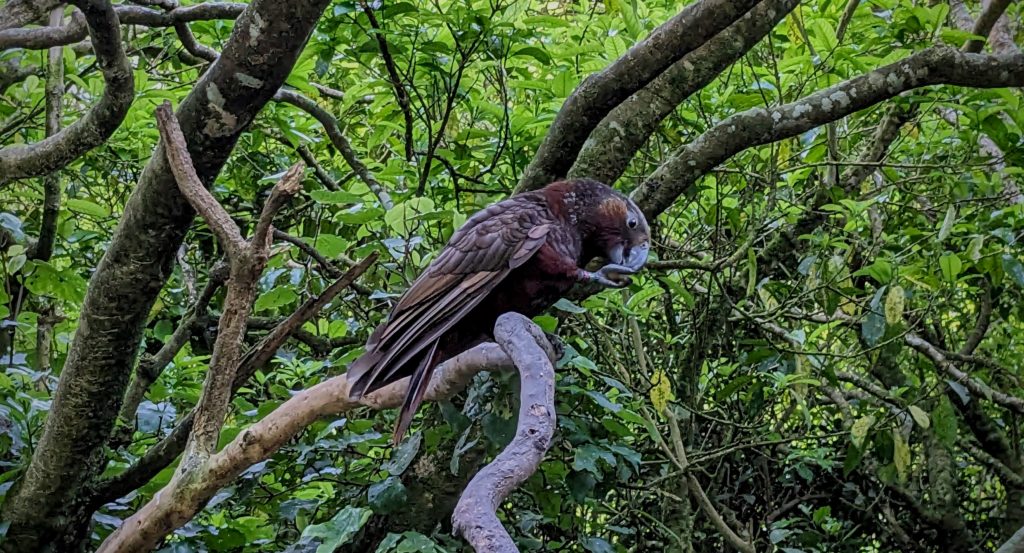
At another stop on our tour we observed several kaka, a large parrot, at a feeding station. The feeders are to encourage the parrots to return to the sanctuary, a safer place to nest, although they are free to fly in and out of the sanctuary.
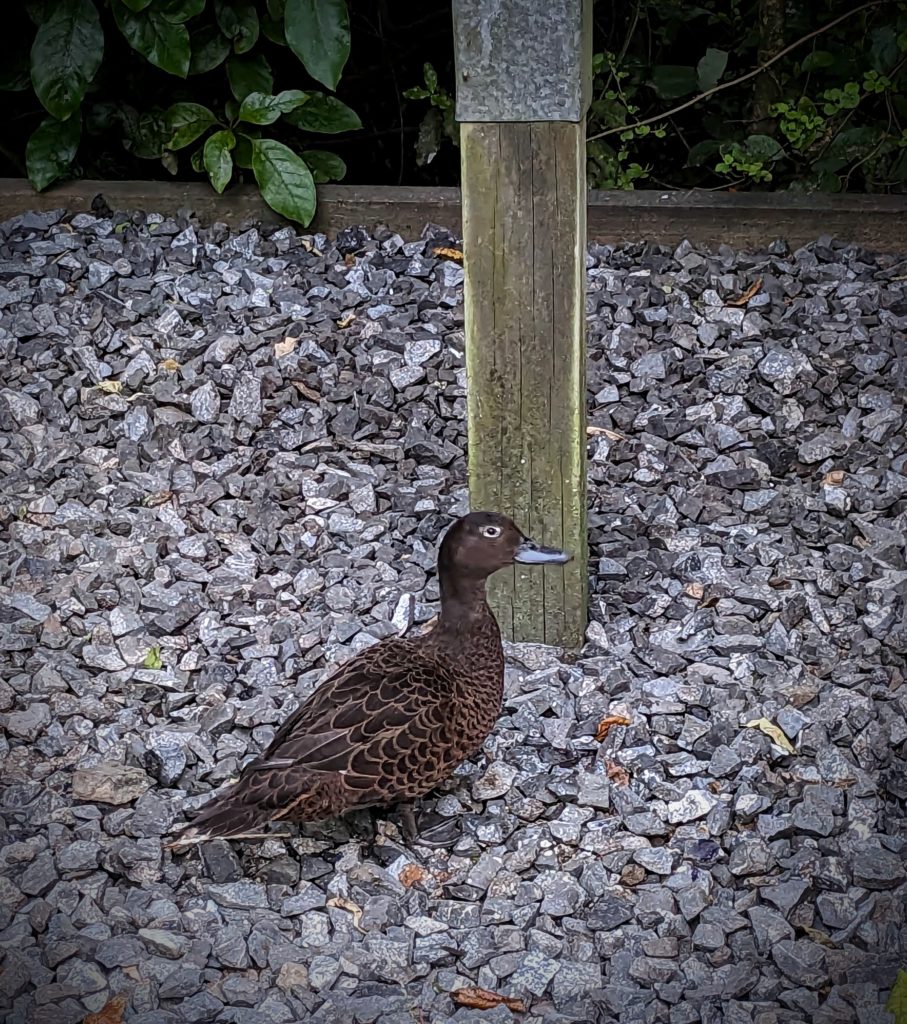
Under the feeding station was a rare duck, a pateke or brown teal, ‘dabbling’ its feet and rooting around in the gravel with its bill for anything the kaka drop, or insects, to eat.
As it darkened we walked through a wetland, on boardwalks over a stream, as our guide pointed out with a red flashlight, tiny fish in the stream, insects bored into tree trunks, and weta that look like giant crickets. As it darkened further she pointed out glow worms under an embankment, and we heard, but did not see kiwi, just waking up for their nocturnal foraging!
We highly recommend Zealandia dusk and night tours! And your ticket allows you entrance the next day so you can check out the sanctuaries diurnal creatures!





































